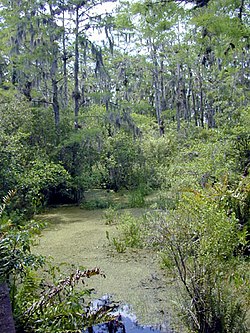Swamp


A swamp is a type of wetland ecosystem. Swamps are forested, low, spongy land generally saturated with water and covered with trees and aquatic plants.[1] Big parts of swamps are often flooded with water. Swamps are nesting and breeding grounds for birds and other animals.
The water of a swamp may be fresh water, brackish water, or seawater. Freshwater swamps form along large rivers or lakes.[2] Saltwater swamps are found along tropical and subtropical coastlines.
About 6 percent of Earth's surface is covered by swamps. Swamps are also filters for groundwater and protect against flooding. Swamps are one of the key wetland areas which are protected by the international agency Ramsar.
Some well-known swamps are:
- The Pantanal is the world's biggest wetland. It covers an area of 140,000 square kilometers, bigger than the area covered by the country Greece. The Panatal is in South America. It is shared by Brazil, Bolivia and Paraguay.[3]
- The Everglades
- The Okefenokee
- The Sundarbans
Peat accumulates in these swamps. Some of the world's largest swamps are found along major rivers such as the Amazon, the Mississippi, and the Congo.[4]
Swamp Media
The Linnaistensuo Mire, a nature reserve swamp in Lahti, Finland.
Swamp in southern Louisiana
A small swamp in Padstow, New South Wales, Australia
Inside a mangrove canopy, Salt Pan Creek, New South Wales
A black alder swamp in Germany
References
- ↑ Swamp Archived 2007-06-10 at the Wayback Machine (from glossary webpage of the United States Geological Survey)
- ↑ Hughes, F.M.R. (ed.). 2003. The Flooded Forest: Guidance for policy makers and river managers in Europe on the restoration of floodplain forests. FLOBAR2, Department of Geography, University of Cambridge, Cambridge, UK. 96 p.
- ↑ "Pantanal in South America declared "Threatened Lake of the Year 2007"". Ramsar Convention Secretariat. February 2007. Retrieved 2008-10-24.
- ↑ Keddy, P.A., L.H. Fraser, A.I. Solomeshch, W.J. Junk, D.R. Campbell, M.T.K. Arroyo and C.J.R. Alho. 2009. Wet and wonderful: the world's largest wetlands are conservation priorities. BioScience 59: 39–51.







